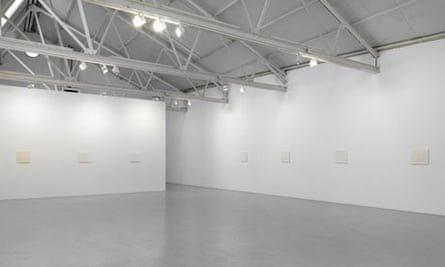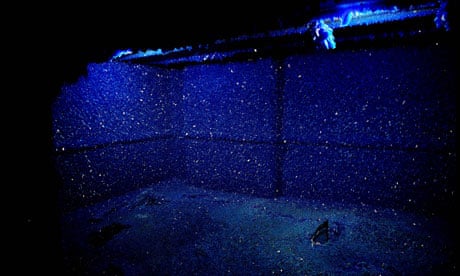First impressions are deceptive in Roger Hiorns's art. His sculptures pull you in with their mysterious good looks, like the naked youth he perched at one end of a public bench while flames licked its metal seat. They can seem both delicate and powerful, as with the thistles, model cathedrals or BMW engines he's dunked in copper sulphate solution so their surfaces grow glittering skins of blue crystal. His abstract steel sculptures, meanwhile, have clean and elegant forms, weighted with the might of industry and enterprise.
Yet something toxic hangs in the air. The crystal landscapes Hiorns sets in motion are corrosive, eating up whatever they embrace in an alien crust. Other works have been impregnated with actual bovine brain matter, the root of mad cow disease paranoia that gripped Britain in the 1980s when the artist was a boy. They worry and nag, pitting our desire for order – whether in the guise of science, religion or clear-cut sexuality – against the threat of creeping chaos posed by disease, madness, or whatever flaunts the norm. Even his series of self-assured hard-edged slabs of steel, a la Richard Serra, have their macho presumptions undercut: they lean nonchalantly against a wall stained with French perfume.

Born in 1975 in Birmingham, Hiorns studied at Goldsmiths college, a decade after the YBAs made their mark there. In the wake of Damien Hirst, he's one of the few artists of his generation to ask the big questions about mortality, belief and meaning. In 2008, he was put squarely in the public eye while earning a Turner prize nomination with his Art Angel project Seizure. Working on a scale to rival Rachel Whiteread's famed House, Hiorns flooded an abandoned flat in a condemned South London housing block with copper sulphate solution. Everything from the light fittings to the bathtub was slowly, irresistibly taken over, metamorphosing into a crepuscular blue crystal cave.
Hiorns has put the chemicals aside since this radical work and his current London show presents a stark contrast to his crystal creations. It features a series of pale sheets circling the gallery like minimal paintings. Get up close enough to sniff them, however, and you can make out a light golden streak of liquid cow brain, tainting the snowy surface.
Why we like him: Untitled, the centrepiece of Hiorns's Turner prize presentation, is a landscape of dust spreading quietly over the floor like a parched grey desert. The dust is in fact the remains of a pulverised passenger jet plane and its hush, that which follows terrible, ear-splitting destruction: the total quiet of the end.
Classic: For the 2007 Athens Biennale, Hiorns smeared the lights of the Parthenon with his own sperm.
Where can I see him? At Corvi Mora, London to 21 April.

Comments (…)
Sign in or create your Guardian account to join the discussion